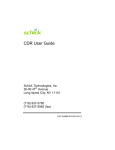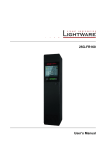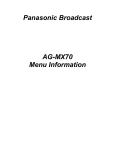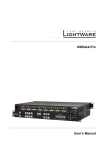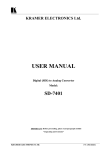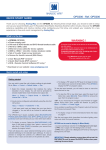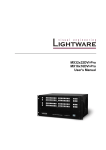Download Sigma Electronics 2100 series Specifications
Transcript
DIGITAL SWITCHERS 2100 SERIES HIGH PERFORMANCE DIGITAL ROUTING OPERATORS MANUAL Includes Module and Frame Information for: AUDIO DAS-2144 DAS-2188 DAS-21616 VIDEO DVS-2144 DVS-2184 DVS-21164 DVM-1616 DVS-1616 SIGMA ELECTRONICS, INC. P.O. Box 448 1027 COMMERCIAL AVENUE EAST PETERSBURG, PA 17520-0448 (717) 569-2681 (MAR 04) 2100 DIGITAL TABLE OF CONTENTS SECTION 1 OPERATORS MANUAL Specifications ............................................................................................. Page Unpacking .................................................................................................. Page Installation .................................................................................................. Page Interconnect Wiring .................................................................................... Page Communication Line Wiring ....................................................................... Page Control Bus Wiring ..................................................................................... Page Serial Port Connections .............................................................................. Page Sync. Reference Input ................................................................................ Page Redundant Power ...................................................................................... Page Split Frame ................................................................................................. Page 2100 Series Compatibility ........................................................................... Page Digital Video General Information .............................................................. Page DVM-1616 Power ....................................................................................... Page System Frames .......................................................................................... Page Video Wiring ............................................................................................... Page DVS-1616, DVM-1616 ..................................................................... Page DVS-2144, DVS-2184 and DVS-21164 .............................................. Page Configuration .............................................................................................. Page Audio Wiring ............................................................................................... Page DAS-2144 Module Drawing ........................................................................ Page DAS-2188 Module Drawing ........................................................................ Page DAS-21616 Module Drawing ...................................................................... Page Control Panels ............................................................................................ Page Multi-Frame Systems ................................................................................. Page 1,2 3 3 3 3 3 3 4 4 4 4 4 4 5 5 5,6 7 7 7 8 9 10 11 11 SECTION 2 SYSTEM CONTROL INTERFACE SCI-2144 or SCI-1616 for DVS-1616 SECTION 3 CONTROL PANEL OPERATION System Control Panel ...... ........................................................................ Multiple Pages SECTION 4 FRAME AND POWER SUPPLY Modular Frame / Power Supply ............ ................................................... Multiple Pages SECTION 5 (OPTIONAL) 2100 SERIES OPTIONS Descriptions for 2100 Series Options ... ................................................... Multiple Pages 2100 DIGITAL Specifications DIGITAL VIDEO SWITCH FRAME (DVS -1616, DVM-1616, DVS-2144, DVS-2184, DVS-21164) DIGITAL VIDEO INPUT: Input Signal ................... ........................................................ 16, Single-ended, terminated 75Ω Input Level ..................... ........................................................ SMPTE 259M, 800 mVp-p Data Rate ...................... ........................................................ 400 Mb/s maximum Input Cable Length (DVS-1616).............................................. 100 ft. (33 meters) maximum (BELDEN 8281) (others) .................................................... 50 ft. maximum (BELDEN 8281) Connectors .................... ........................................................ BNC DIGITAL VIDEO OUTPUT: Output Signal ............................... .......................................... Output Return Loss ................... ............................................. Output To Output Isolation (DVS-1616).... .............................. (others)......................................... Overshoot ............................................................................... Connectors ............................................................................. 16 Outputs, 800 mVp-p typical, ±10% 15 dB minimum, 5 MHz to 270 MHz 20 dB minimum, 5 MHz to 270 MHz >45 dB, 5 MHz to 270 MHz 10% maximum of total signal BNC GENERAL: Power Requirements (DVS-1616)........................................... 120 VAC 50/60 Hz, 3A slow blow fuse ........................................ ........................................................ 230 VAC 50/60 Hz, 1.5A slow blow fuse Power Consumption (DVS-1616)............................................ 13 Watts typical Operational Temperature ....................................................... 0° to 50° C (+32° to +122° F) Size (DVS-1616).................................................... ................. 19” W x 1.7” H x 8.2” D (483 x 43.2 x 208 mm) (DVS-2144 – 1 slot, DVS-2184 – 2 slots, DVS-21164- 4 slots in 2100 system frame) DIGITAL AUDIO SWITCH MODULE (DAS-2144, DAS-2188, DAS-21616) Inputs ............................ ........................................................ Differential, Terminated Input Level ..................... ........................................................ 7 Vp-p maximum Input Coupling ............... ........................................................ Transformer Coupled, AES-3 1992 Input Impedance ........... ........................................................ 110 Ω Outputs .......................... ........................................................ Differential Output Level .................. ........................................................ 7 Vp-p maximum, 3.7 Vp-p typical Output Impedance ......... ........................................................ 110 Ω Output to Output Isolation ...................................................... 50 dB minimum Rise and Fall Time ........ ........................................................ 5nS < tr < 30 nS, 10% to 90% (rise time) ........................................ ........................................................ 5nS < tf < 30 nS, 10% to 90% (fall time) Serial Data Jitter ............ ........................................................ ± 20 nS Maximum Input Cable Length ........ ........................................................ 500 ft. maximum (Belden 1800A or equivalent) Input Common Mode Rejection ............................................. 7 V Peak from DC to 20 kHz Output Common Mode Noise ................................................ 30 dB Minimum below signal from DC to 6 MHz Electrical Length ............ ........................................................ 70 nS typical Connectors .................... ........................................................ 3 Pin Detachable terminals (continued next page) 2100 Digital Page 1 2100 DIGITAL Specifications (cont.) SYSTEM CONTROL INTERFACE MODULE (SCI-2144) Data Transmission System .................................................... Serial Port Baud Rate ... ........................................................ Control Levels ............... ........................................................ Communication Line ..... ........................................................ Control Panels ............... ........................................................ Protocol ......................... ........................................................ External Sync Reference ....................................................... Connectors .................... ........................................................ ........................................ ........................................................ RS-232 & RS-422 4,800, 9,600, 19,200, 38,400 baud 4 Coaxial, up to 2000 feet Up to 16 on Comm. Line Simple ASCII, supports Xon/Xoff Composite Sync or Blackburst BNC for Comm. Line and Ext. Sync. 9 Pin “D” for Serial Port ENVIRONMENTAL Operational Temperature ....................................................... 0 to 50° C MECHANICAL Switch Frame, Master Control Panel Single Bus Panels SS-2100-6 ....................................... 1RU, 1.75” H x 19” W x 9.5” D SS-2100-16+ ................................... 3RU, 5.25” H x 19” W x 9.5” D HSY-16S, RC-1640 ....................... 2RU, 3.48” H x 19” W x 1.75” D HSY-1616, RC-840, SYC-88 ......... 1RU, 1.74” H x 19” W x 1.75” D HSB-16, SBC-16 ........................... 1RU, 1.74” H x 19” W x 1.75” D POWER REQUIREMENT Voltage (Specify at time of order) ...........................................115 VAC or 230 VAC, 50/60 Hz Power Consumption, 1 RU Frame ................................... 40 W maximum, per frame 3 RU Frame ................................... 100 W maximum, per frame Supply model / Fuse SS-2100-6 (120 VAC) ................... APA-2100-6 with WT-2100-6, 2A SS-2100-6 (230 VAC) ................... APA-2100-6 with WT-2101-6, 2A SS-2100-16+ (120 VAC) ............... FPS-2100, 2A SS-2100-16+ (230 VAC) ............... FPS-2101, 1A Specifications are subject to change without notice. 2100 Digital Page 2 UNPACKING Inspect your packages and equipment for any damage that may have occurred during shipping. Report any damages to both Sigma Electronics, Inc. and your shipping company. It is the buyer’s responsibility to file a claim against the shipping company for cost of repair due to shipping damage. 2100 Series frames are shipped fully loaded within the shipping carton. The frame includes the power supply and required system modules. Remove the fully loaded frame from the carton. The Operator’s Manual is packed within the same carton as the frame. Systems configured within the SS-2100-6 frame will contain a wall transformer within the frame’s carton. Control Panels are shipped in separate cartons. The “Wall Mount” power supply for the control panel is in the same carton as the control panel. INSTALLATION All frames and control panels are intended to be mounted in standard 19” EIA equipment racks. To allow frame installation into a rack, remove the front door. The SS-2100-16+ frame has two screws used to retain the front panel during shipping. Remove these screws before attempting to mount the frame into a rack. After mounting the frame into the rack, the front door is held into place by the ball stud and retaining clip hardware. Frames are designed for maximum ventilation of normal operational heat production. When feasible leave 1RU (1.75”) space between frames and other equipment within the rack to assist ventilation. The Master Frame, in multi-frame systems, is the frame containing the SCI-2144 System Control Interface Module. The position of the Master Frame may be anywhere within reach of the Control Bus interconnect cable supplied with the system. Ease of wiring the video and audio Source and destination cables may dictate position of each frame in multi-framed systems. INTERCONNECT WIRING After racking the system, the Video and/or Audio signals must be connected to the router modules. Connections to the SCI-2144 will allow control of the router. All these connections are located at the rear of the frame. The following information is a guideline to perform the interconnect wiring. COMMUNICATIONS LINE WIRING References to the control panel's communication line are typically abbreviated to COMM Line. All of the control panels are connected to the System Control Interface SCI-2144 via a coaxial cable. There is one COMM Line BNC connector on the rear of the Master frame that houses the SCI-2144. Installation of the Master Control panel in a system requires a 75Ω coaxial cable connection between the COMM Line BNCs. Connect a coaxial cable between the COMM Line BNC of the SCI-2144 and the COMM connection BNC on the rear of the control panel. Up to 16 control panels may be added to the COMM Line as system requirements dictate. Additional panels are added by installing BNC “T” connectors in the coax path. Short coax cables may be used between the “T” and the new panel or the “T” may be connected directly to the panel. Total coaxial cable paths are recommended to be within 2000 feet. This coaxial path should NOT be terminated in a 75Ω load. CONTROL BUS WIRING Systems with multiple frames use an SLV-2126 module or SLC-2102 kit to transfer the control data between frames. The control data transfer modules interface via a ribbon cable with 9 Pin D-type connectors. There are two 9 Pin connectors on each card. Either connector may be used. The interface cable supplied is 18 inches in length. Frame placement within the racks will determine the required length of the bus cable. If the supplied cable does not meet the site requirements a straight pin to pin 9 Pin Sub-D custom cable may be used. SERIAL PORT CONNECTIONS Sigma’s custom RS-232 and RS-422 protocol may be used for external control of the system. This provides a method to allow computer control, modem control, or other third party control devices to communicate with the SCI2144. The 9 Pin D-type Serial I/O connector is used for this purpose. It is located on the rear of the Master frame on the SCI-2144 (or SCI-1616 in the DVS-1616). The pin assignment and wiring information is provided in the SCI section of this manual. 2100 Digital Page 3 SYNC REFERENCE Sync reference may be applied to the SCI-2144 (or SCI-1616 in the DVS-1616). The routing switcher will switch during the vertical interval of the reference signal when applied. This signal is applied to the REF IN input on the rear of the Master frame. In the SCI-2144, the signal is not internally terminated and must be terminated if not looping through the system. More detailed information is provided in the operator’s manual concerning the differences in the DVS-1616. This signal can be either Composite Video (1Vp-p) or Composite Sync Pulse (4Vp-p). A jumper, J4, is provided on the SCI-2144 to properly compensate for the sync-reference signal level. Use the “Comp” position of J4 for 1Vp-p signals (jumper pins 2 and 3) and the “Drive” position for 4Vp-p signals ( jumper pins 1 and 2). If no signal is present on the REF IN input BNC, the SCI-2144 will execute the switch as soon as it interprets the command. This may result in non-synchronous switching. REDUNDANT POWER The 2100 Series can be configured with a 3RU frame that contains a redundant power supply. The dual power supplies operate simultaneously. When the 3RU frame contains a redundant power supply the number of card slots available drops from seventeen to thirteen. SPLIT FRAME The SS-2100-16+ frame has a switch in the center of the mother board. The switch provides the option to open the control bus. The open control bus partitions the frame into two separate switch systems within one frame. An SCI2144 would be required for each system. One side of the frame allows eight card slots the other nine card slots. This makes the split frame configuration suitable for an 8x8 router of composite video with either mono or stereo audio. 2100 SERIES COMPATIBILITY The 2100 frames are designed to hold any combination of 2100 Series modules. This allows the frame to support not only the routing modules but also modules for distribution of various signal formats, sync and pattern generators and signal transcoders, converters, encoders or decoders. The flexibility of this frame design allows the router to mix routing modules. Matrix sizes of 4x4 to 16x16 can be combined under a common control scheme. This also allows balanced and unbalanced audio modules to be combined within a system. Any 2100 series routing module can be used to configure custom operating systems. Control panels from any other 2100 Series system can be used to enhance or limit the control capabilities of multiple control locations. Panels with full X-Y control with or without breakaway capability are available. A panel with full output status of each output is available. Single bus panels with or without breakaway are also available. The system has panel addressing capabilities to allow up to sixteen control panels to interface to the router. DIGITAL VIDEO GENERAL INFORMATION: The DVS-2144, DVS-2184 and DVS-21164 are full cross-point matrix switchers of 4, 8 or 16 inputs to 4 outputs. The DVM-1616 or DVS-1616 are full, crosspoint-matrix switchers of 16 inputs to 16 outputs. These units are designed for Serial Digital signal format SMPTE 259M, CCIR 601 and embedded AES/EBU audio and auxiliary data into digital video per SMPTE 272M. The DVM-1616 requires access to a separate SCI-2144 module for system control. The DVS-2144, DVS-2184 and DVS-21164 would normally receive their control data from the SCI-2144 through the frame motherboard. The control data generated in the Master frame must be looped to the DVM-1616 via a control-data, looping module, SLV-2126. The SLV-2126 module consumes a card slot within the Master frame and supplies a data cable that connects to the DVM-1616. Data rates of 143, 177, 270 and 360 Mb/s are compatible with this switcher. This refers to data rates for serial digital video signals of 4fsc NTSC composite, 4fsc PAL composite, and 4:2:2 sampling ratio of component video (NTSC or PAL format) respectively. Neither unit provides equalization or reclocking circuitry on the inputs and therefore the input cable lengths should not exceed 100 feet (33 meters) of Belden 8281 or equivalent. If cable lengths exceed the specifications for the switcher, there are devices available to correct signal degradation for those applications. POWER: (DVM/DVS-1616 only) The unit operates from line voltage of 120 VAC or 230 VAC dependent upon the configuration of the power supply module. Internally the power supply provides a +5 VDC source for the circuit boards contained within the frame. The PSD-1616 power supply module regulates the bus voltage to +5 VDC via the regulator U1 and associated circuitry. Circuit protection is provided by fuse F1. 2100 Digital Page 4 FRAME: The DVM-1616/DVS-1616 system is provided in a frame designed for rack mounting. The 1 RU frame provides mounting tabs for a standard 19 inch EIA rack cabinet. All components are mounted into the frame from the rear of the unit. This frame does not provide additional card slots for insertion of other 2100 Series modules. The DAS-21xx and DVS-21xx modules can reside in some of four different frames provided by Sigma Electronics, Inc. If these modules are purchased as a component of a system, please refer to the SERIES 2100 FRAMES Instruction Manual. If the module was purchased separately, an existing frame must be present for proper operation. Sigma would like to emphasize the fact that any of the Series 2100 Digital modules can be combined in a common frame with other modules and they must be controlled by a separate control module like the SCI-2144. ♦ The SS-2100-2 frame is designed for desktop applications. This frame provides two (2) slots and can therefore only accommodate the DVS-2144 or DAS-2144 and the SCI-2144 controller module. ♦ The SS-2100-6, 1RU frame is designed for 19-inch EIA rack installations. This frame can accommodate some of the DAS-21xx and DVS-21xx modules along with the SCI-2144 controller module. It provides six (6) slots for modules. ♦ The SS-2100-12+ frame provides thirteen (13) slots for modules within 3 RU. A redundant power supplies can be provided within this frame. This frame can accommodate the DAS-21xx and DVS-21xx modules and the SCI-2144 controller module. ♦ The SS-2100-16+ frame is also available for installations in a 19-inch EIA rack. This frame provides seventeen (17) slots for modules within 3 RU. This frame can accommodate the DAS-21xx and DVS-21xx modules and its SCI2144 controller module. VIDEO WIRING: The video switch inputs are terminating. If the application requires a looping configuration, use a distribution amplifier on the input signal to send the source signal to multiple devices. This provides the video source with proper 75Ω termination. Simply connect the source video cables to corresponding input BNCs on the rear of the video routing frame. Refer to the sections below to review drawings for input and output layout. Sigma Electronics’ connector layout is designed to economically maximize performance. The source video cable connects to the video input on the rear panel. The outputs of the video router connect to destination devices. Some devices may be both source and destination devices. Connect the source signal from the device’s output to the routers input. The destination's input receives a signal from the router’s output. DVS-1616 and DVM-1616 Connectors for wiring of source signals and destination devices are located on the rear panel. The inputs, outputs, Comm. bus and sync reference input use BNCs. A 9 pin D connector is provided for the SCI RS-232/422 interface on the DVS-1616 model. The DVM-1616 has a 9 pin D connector for control data from a master frame. SERIAL DIGITAL VIDEO INPUT: The BNC connectors to the left of center on the rear panel provide the 16 Serial Digital video inputs. Each BNC is a 75Ω terminated connection. SERIAL DIGITAL VIDEO OUTPUT: The BNC connectors to the right of center on the rear panel provide the 16 Serial Digital video outputs. Each output utilized requires a 75Ω terminated destination. The unused outputs do not require a 75Ω load. SYSTEM CONTROL: There are several methods of configuring system control. Take note that the DVS-1616 is complete with an SCI. The DVM-1616 does not include an SCI and therefore requires control data from a master frame. The DVS-1616 has a BNC labeled “COMM” which is used to connect a coaxial cable to a remote control panel. Multiple control panels are attached via BNC ‘T’ connectors at each panel to perform a looping network. Total cable distance can be up to 2000 feet. The system can support as many as sixteen control panels. The DVS-1616 includes the SCI-1616 which provides a 9 pin D connector for external control of RS-232/RS-422 protocol. This system uses the SCI-1616 module which operates from SCI-2144 protocol which is standard for the 2100 Series. The SCI is located on the rear far left side of the frame. The DVM-1616 does not include an SCI-1616 module or control panel and therefore is dependent upon a master frame for control. The control data from the master frame is provided by an optional SLV-2126. This is a single slot module which mounts in the master frame. Along with the module is an interface cable with 9 pin D connectors. The control data enters the DVM-1616 at the 9 pin D connector on the power supply module located on the right side on the rear of the frame. There is no direct connection for control on the DVM-1616. All control communications must be connected to the master frame. Note that the DVM-1616 requires a control scheme of 16 inputs to 16 outputs. If the master frame is configured in a smaller matrix the SCI in the master frame will need to be reconfigured for 16x16. This is achieved by the DIP switch selection on the SCI within the master frame. Refer to the protocol section of the operation manual for the master frame. 2100 Digital Page 5 DVS-1616 and DVM-1616 SERIES 2100 DVS-1616 SIGMA ELECTRONICS, INC. DVS-1616 FRONT PANEL SCI 1616 CONTROL BUS CLEAR 2 4 6 SERIAL I/O 1 REF IN S1 3 8 10 INPUTS 7 9 5 12 11 14 13 16 1 3 5 2 15 7 4 9 11 OUTPUT 8S 10 6 13 12 15 14 16 FUSE 3.0 AMP SLO-BLO 120 VAC COMM System Control Interface Serial Digital Serial Digital Video Input Video Output DVS-1616 REAR PANEL CONNECTIONS Figure 1 SERIES 2100 Power Supply DVS-1616 SIGMA ELECTRONICS, INC. DVM-1616 FRONT PANEL 2 1 4 3 6 5 8 INPUTS 7 9 10 12 11 14 13 16 15 1 3 2 5 4 7 6 9 11 OUTPUT 8S 10 13 12 Serial Digital Serial Digital Video Input Video Output DVM-1616 REAR PANEL CONNECTIONS Figure 2 2100 Digital Page 6 CONTROL BUS 15 14 16 FUSE 3.0 AMP SLO-BLO 120 VAC Power Supply & Control Bus DVS-2144, DVS-2184 AND DVS-21164 The DVS-2144 is a four-input to four-output video switch, the DVS-2184 is an eight input to four output video switch and the DVS-21164 is a sixteen input to four output video switch. The inputs; arranged in ascending numerical order, top to bottom; are on the left side of the rear panel. The outputs 1 to 4 are located to the right of the inputs. DVS-2144, DVS-2184 and DVS-21164 REAR PANEL CONNECTIONS CONFIGURATION: The DVS-2144, DVS-2184 and DVS-21164 all slide into the 2100 system frames from the rear. The DVS/DVM1616 has a motherboard that slides into its 1RU frame from the rear. This PCB contains all the input, crosspoint and output driver circuitry. The following information is provided for custom configuration of the digital video control bus. The factory settings provide control of the digital video frame normally on level four. The jumpers provided on the modules are set at factory default conditions. The main module should not require any reconfiguration for normal operation. A soldered wire jumper is provided for control level selection. In typical systems, the main video is set to Level 1 and audio is set to Level 2. Therefore, the following defaults are used. LEVEL JUMPER: This is a soldered wire jumper located near the front edge of the printed circuit board. There are five holes labeled “C or W2A”, “1”, “2”, “3”, and ”4” to the right of the silk screen label of “LEVELS”. Model: DVM-1616, Jumper configured for level 4 control (“C” and “4” positions jumped). Typically, this model functions as an add-on frame to a master system. The master frame may already have level 1 video and/or level 2 audio modules. OUTPUTS JUMPER (DVS/DVM-1616 ONLY): Do NOT reconfigure this jumper. The DVS/DVM-1616 must use the “1-16” position. AUDIO WIRING Differential Audio connections are provided via 3 position detachable terminal blocks. There is an individual connector assigned for each input and output. Where audio signals need to be bridged from the audio switch module to another device, the use of digital, audio distribution amplifiers is recommended. Refer to the digital, audio module drawings that follow for locations of the input and output connectors. Each detachable connector is marked for polarity and keyed for insertion of the plug into the receiving header. 2100 Digital Page 7 DAS-2144 Module Block Diagram DAS-2144 W1 - Level Jumper J6 Logic IC Control Bus CROSS-POINTS Differential Receivers Differential Drivers INPUTS 1 TO 4 The 4x4 digital audio switcher is provided as a one-slot width module. The rear panel has inputs on the top half and outputs on the bottom half of the module. The main PCB, also identified as DAS2144, is directly attached to the rear panel. This card plugs into the frame that supplies power and control data. The Level jumper, W1, sets the control level. The control level is typically factory-set to Level 2 for audio. The input group is set by the position of jumper J6. The default setting is 1-8. The output group on this card is set at the factory and should not be changed. OUTPUTS 1 TO 4 W1 Settings Control Level Control Level # 1 2 3 4 W1 ORIGIN C C C C W1 DEST. 1 2 3 4 J6 Settings Input Group Group Level 1-8 9 - 16 J6 Position 2-3 1-2 Rear View 2100 Digital Page 8 DAS-2188 Module Block Diagram DAO-108 DAI-108 P1 J5 / J6 S1 Level / Matrix / Group Logic IC Control Bus CROSS-POINTS Differential Receivers Differential Drivers INPUTS 1 TO 8 OUTPUTS 1 TO 8 S1 Settings Output Group / Matrix / Control Level S1-1 Matrix S1-2 Control Level # ON 8x8 ON 1 OFF 16x8 OFF 2 3 4 Output Group 1 to 8 9 to 16 S1-3 S1-4 ON ON OFF OFF ON OFF ON OFF DAS 2188 Inputs + C - + C - Outputs + C - + C - 1 1 2 + C - + C - 2 + C - + C - 3 3 4 + C - + C - + C - + C - 4 + C - + C - + C - + C - 5 4 3 2 1 ON 5 6 6 7 7 8 Inputs S1 8 Outputs DAS 2188 Rear View OUTPUT INPUT Front View 2100 Digital Page 9 The 8x8 digital audio is provided as a two card slot width module. The rear panel has inputs on the left half of the module. The input card, DAI-108, is attached to the input connector panel. Outputs are located on the right half of the rear panel. An output card DAO-108 is attached to the back panel. This card plugs into the frame that supplies power and control data. The Level / Group switch, S1, sets the control level as well as the matrix configuration and output group. The control level is typically factory set to Level 2 for audio. The input group is defaulted to 1-8. The output group on this card should be set to 1-8. The matrix setting should be set to 8x8 for this module. Refer to the S1 switch chart to customize the settings for special applications. DAS-21616 DAO-916 Module Block Diagram S1 Level/Group S1 Level/Group Logic Logic Control Bus DAO-108 Control Bus J7 U4 Crosspoints U4 Crosspoints DAI-916 Output Drivers Output Drivers DAI-108 P1 INPUTS 9-16 OUTPUTS 9-16 OUTPUTS 1-8 INPUTS 1-8 S1 Settings Output Group, Matrix Size and Control Level S1-1 Matrix S1-2 Control S1-3 Size Level ON 8x8 ON 1 ON OFF 16x16 OFF 2 ON 3 OFF 4 OFF Output Group 1-8 9-16 Inputs Inputs + C - + C - + C - + C - + C - + C - + C - + C - + C - 9 + C - + C - + C - + C - + C - + C - + C - C - + C - + C - + C - + C - + C - + C - + C - - + C - + C - + C - + C - + C - + C - 9 10 11 12 ON S1 4 3 2 1 ON 14 7 8 S1 4 3 2 1 13 6 8 Inputs C 5 7 16 + 4 6 15 - 3 5 14 C 2 4 13 + 1 3 12 Inputs + 2 11 ON OFF ON OFF Outputs Outputs 1 10 S1-4 15 16 Outputs Outputs DAS 1616 Rear View OUTPUT OUTPUT INPUT INPUT Front View 2100 Digital Page 10 The 16x16 digital audio is provided in a four card slot width module. Inputs are provided on the left side of the rear panel. Outputs are located on the right side of the rear panel. Four cards are used to process the signals. The output card, DAO-108 receives power from the frame to support input circuitry and outputs 1 to 8. The output card DAO-916 receives power from the frame for output group 9 to 16. The DAO108 receives control data from the frame for it’s crosspoints and the DAO-916 receives control data from the frame for its crosspoints. The output cards receive the audio input signals from the two input cards via P1, on the DAI-108 and P1 on the DAI-916. The output card performs the crosspoint switching function. The Output Group / Matrix Size / Control Level Select switch, S1, sets the logical control level, the size of the matrix and output group. It is located on the output cards (DAO-108 and DAO-916). The control level is typically defaulted to Level 2 for audio. The matrix size on both modules should be set to 16x16. The output group select should be set to 1-8 for the DAO-108 and group 9-16 for the DAO-916 card. Refer to the S1 Settings chart for other control level settings. Multiple modules may be present if the system is configured for multiple levels of switching. For example: Use a module for all audio on a level 2 control and another module for all audio on a level 4 control. This allows two sets of digital signals to be controlled by one master control panel. Set the levels of each module to different control levels and they will switch independently from one another. Please note that video modules are typically defaulted to level 1. Do not use level 1 for audio unless audio is to follow the video source. Control Panels The 2100 Digital Series routers will function with any of the 2100 Series Control Panels. The control panels have address switches that allow addressing from one (1) through sixteen (16). There may be as many as sixteen panels on each router system. The panels may be a mixture of Full X-Y master control panels or Single Bus panels that control only one selected output. Most panels offer the selection to operate in either a Preset or Auto-Take mode. The Preset mode allows the user to select a source and desired destination and hold that “preset” until the TAKE button is depressed. The AutoTake mode will automatically perform the “take” function when the destination number is selected. Some panels allow the user to select the mode of operation via a switch on the rear of the control panel housing. Other streamlined panels provide autotake mode only. Refer to the Control Panel section of this manual for specific operation information for the supplied control panel(s). The required control panel interface cable is 75-ohm coax. The total length of the cable should not exceed 2000 feet. If multiple panels are to be connected to the system, BNC ‘T’ connectors should be used to split the communication (COMM) line. The COMM line can be configured in either a daisy chain, star or mixture of both configurations. Cable lengths should be kept to a minimum for best system operation. No 75-ohm termination is required All control panels will be allowed the same priority on the router system. There are no user level priorities available to limit the control of any given panel. Some control panels do allow the setting of control levels that would allow a panel to restrict control of video only or audio only. Multi-Frame Systems When system configuration requires more than one frame to house the modules, the control data must be looped from the master frame, which contains the SCI-2144, to any additional frames. The control data contains the Control Level and Crosspoint information generated by the SCI-2144. The transfer of control data between frames requires an interface module in each frame with a flexible ribbon cable attached to each module. When two frames are in a routing system the SLC-2102 kit is required. This kit contains two modules, one for each frame, and an interface cable. The cable is typically 18 inches as supplied by the factory. Longer cables may be used when the application does not allow the frames to be mounted together in the rack mount frame. The 9 Pin D connectors used on this cable are wired pin to pin. The modules supplied with the SLC-2102 have two connectors each. Either connector may be used. The alternative connector will be used for communicating to additional frames. If more than two frames are used the additional frames require only the SLV-2126 kit. This kit contains one single card slot module and a cable. The module mounts into the frame with the cable attached between the module and an available 9 Pin D connector on the SLV-2126 located in the master frame. If 2100 Series frames are used only for modules other than routing, there is not a need to interface the frames. This applies to frames that house analog or digital distribution amplifiers, transcoders, encoders, decoders and sync generator modules. The control-data looping kits are only required when multiple frames house routing modules. 2100 Digital Page 11 REV 5 Specifications and performance subject to change without notice. MAR 04 2100 Series Digital Switchers













